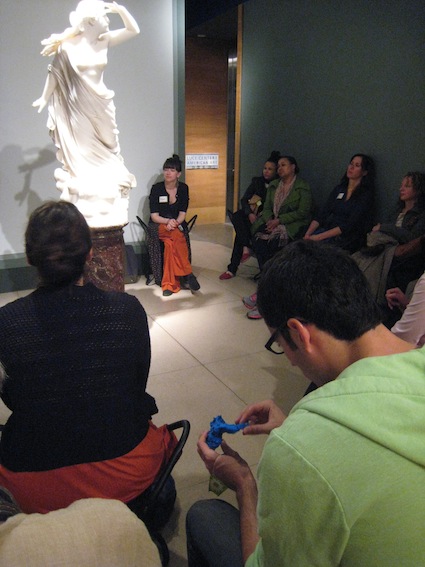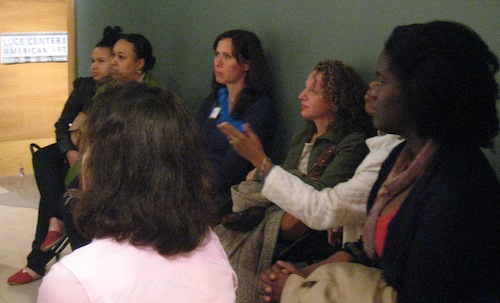Teaching with a 3D Simulacrum
When Shelley and David brought up the idea of 3D printing, my not-so-inner tech geek and my really-blatantly-outer education geek got pretty excited. As Shelley mentioned in her previous post, 3D printing is a hot topic in the museum world right now, with some exciting experimentation happening around the world. Just this week I was at a meeting at the American Museum of Natural History, hearing about some of the exciting 3D printing projects they’re working on with some of their teen programs.
In our use it made sense to start with the Sensory Tour, our monthly tour for visitors with visual impairments as well as anyone who wants to experience art using more than just their sense of sight. We continually had great success using raised line drawings (they’re just what they sound like; the lines are literally raised from the surface of the paper) to help people feel contours of two-dimensional art. Why not try the same thing with one more dimension in the mix?
It took some creative thinking and interdepartmental teamwork to figure out an appropriate object and Lost Pleiad hit all the right marks. So, armed with a few 3D prints of Randolph Rogers’ sculpture in our teaching bag, we hit the galleries in the capable teaching hands of Megan Holland and Brigitte Moreno to “explore lines of ink on paper, lines of movement, and lines of poetry in our most recent exhibition, Fine Lines: American Drawings from the Brooklyn Museum.”
So, how did it go, you’re probably wondering? Did having these touchable models deepen participants’ engagement with the artwork? Did people walk away feeling like they’d had a satisfying tactile experience with this sculpture? Is 3D printing going to usurp the place of the statue in museums? These are all things that were on the minds of the educators as we stepped into this new semi-charted territory.

As with most complicated issues, the results were mixed. Visitors were visibly, physically excited by the prospect of our inclusion of this technology. They paid careful, detailed attention to the surface of the sculpture and all of its contours. They held up the 3D models and compared them to the original sculpture in front of them.
 They looked at the 3D prints from all angles (more than they were able to do with the original, and not unlike the animation commenter Sebastian Heath made from the Thingiverse files David shared in his last post).
They looked at the 3D prints from all angles (more than they were able to do with the original, and not unlike the animation commenter Sebastian Heath made from the Thingiverse files David shared in his last post).
During this Sensory Tour, we also passed around samples of marble in various finishes and scarves to think about the contrast between the dense stone and the diaphanous fabric. People gave them similar amounts of time and attention as they had the 3D prints, but the stone and scarves seemed to spark a wider variety of conversation and brought people’s focus back to the sculpture more quickly. Not that this is all on the technology, of course, but as educators we’re pretty comfortable using material like the stone samples and scarves to get quality audience conversation going.
The 3D prints are new tools for us to play with, and we need to work with them more to get more comfortable. What are the best kinds of questions to ask people when we put these into their hands? As blogged about by Alastair Somerville, does it work better to manipulate the image for emphasis, rather than staying strictly true to the original?
In our post-game conversation, the education team behind the Sensory Tours agreed that 3D prints are great tools to help people feel the weight and balance of a sculpture. They’re “a new way of making lines; a digital brushstroke,” said one educator, and since this month’s Sensory Tour was focused on lines, we couldn’t think of a better place in starting this project.

Rachel is a Museum Educator at the Brooklyn Museum who coordinates ongoing partnerships with public schools around New York City. She works with the museum’s Access Team to create programs that welcome everyone to the museum, and looks for ways that technology and sensory learning can help visitors of all kinds add their voices to the conversation about art. Rachel has a B.A. from Wellesley College and an M.A. from the Courtauld Institute of Art, and she enjoys jazz dance classes, reading in some of the many coffee shops of Brooklyn, and tweeting as @TheArtRopeik.
